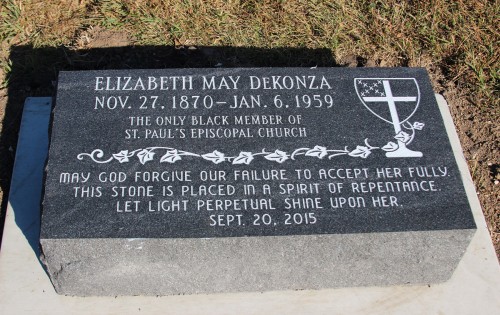St. Paul’s Episcopal in Clay Center, Kansas, joined by parishioners from Ward Chapel AME Church in Junction City, held a service of repentance on September 20, remembering the parishioner that so many of its congregation ignored during the 59 years she was a member of St. Paul’s – its only African-American member. The Episcopal News Service has published a feature on Mai DeKonza’s life, and on the remembrance of it:
DeKonza, who was confirmed in 1900 in the small church in north-central Kansas, was a poet, musician, playwright and prolific letter writer who mostly was ignored by her fellow church members during her 59-year membership. Her separation from them was even more complete by their use of a designated chalice to administer communion only to her.
Now, to help give her a voice in the church that she didn’t have in life, the service included excerpts from letters she had written to Bishop James Wise, the fourth bishop of Kansas who served from 1916 to 1939, as well as a hymn she wrote that had been arranged by parish organist Sandra Carlson to the tune Finlandia.
And when it came time for communion, the only chalice on the altar was the one that had been reserved for DeKonza.
Priest-in-Charge the Reverend Lavonne Seifert gave the sermon, and Dean Wolfe, Bishop of Kansas, sent remarks that were published in the leaflet. Retired psychologist and hobby geneaologist Jim Beck read about DeKonza in a 1981 history of the church, and did additional research, finding out more about the woman who had found her way to the Episcopal Church, and to St. Paul’s, and didn’t leave, despite the congregation’s treatment of her.
As a child DeKonza contracted typhoid fever that left her disabled and required the use of crutches to walk. Although she had only an eighth-grade education, she worked as a music teacher, stenographer, seamstress and light housekeeper.
She also composed and performed music, and wrote poetry and dramas, some of which were published. She gave speeches and lectures about race, and she became active in politics, including support of Prohibition.
Kansas Bishop James Wise was
On April 11, 1934, she wrote to Wise that in spite of her sense of alienation from the church, she had tried to attend Easter service, making the 11-block walk on her crutches. She discovered that the church had changed the service time from 8 a.m. to 6 a.m., and she arrived just as people were finishing breakfast.
She wrote, “And I thought, as I saw them enjoying themselves so merrily, Easter morning, that if the church had requested them to make up an Easter box for African heathen, how gladly they would have given to it; but nobody in St. Paul’s thought of me, of the African race, right at hand, with an Easter egg, or card, or message of cheer, nor of suggesting that a bite of their fine Easter breakfast be sent to me. They simply forgot me.”
After her death, DeKonza’s funeral was held at a mortuary, not at the church, and she was buried in an unmarked pauper’s grave. Following September’s service, most of the congregation drove to the local cemetery to dedicate her new grave marker, paid for by donations from the church members, and designed in collaboration with a local monument company:
It includes the outline of a chalice, with an Episcopal shield forming its bowl. It is surrounded by ivy, which the monument company told them was a symbol of strength.

